Contentions of Fact and Law Analysis
VerifiedAdded on 2020/02/05
|18
|5671
|35
Case Study
AI Summary
This case study examines the contentions of fact and law surrounding Mr. Chu's visa application under the Australian Migration Act 1958. It discusses the legal framework, including relevant sections of the Act, and analyzes the reasons for the refusal of Mr. Chu's visa application. The study highlights the importance of meeting specific criteria for visa approval and the implications of the Administrative Appeals Tribunal's decisions. Through a detailed examination of the case, the study provides insights into the complexities of immigration law and the challenges faced by applicants.
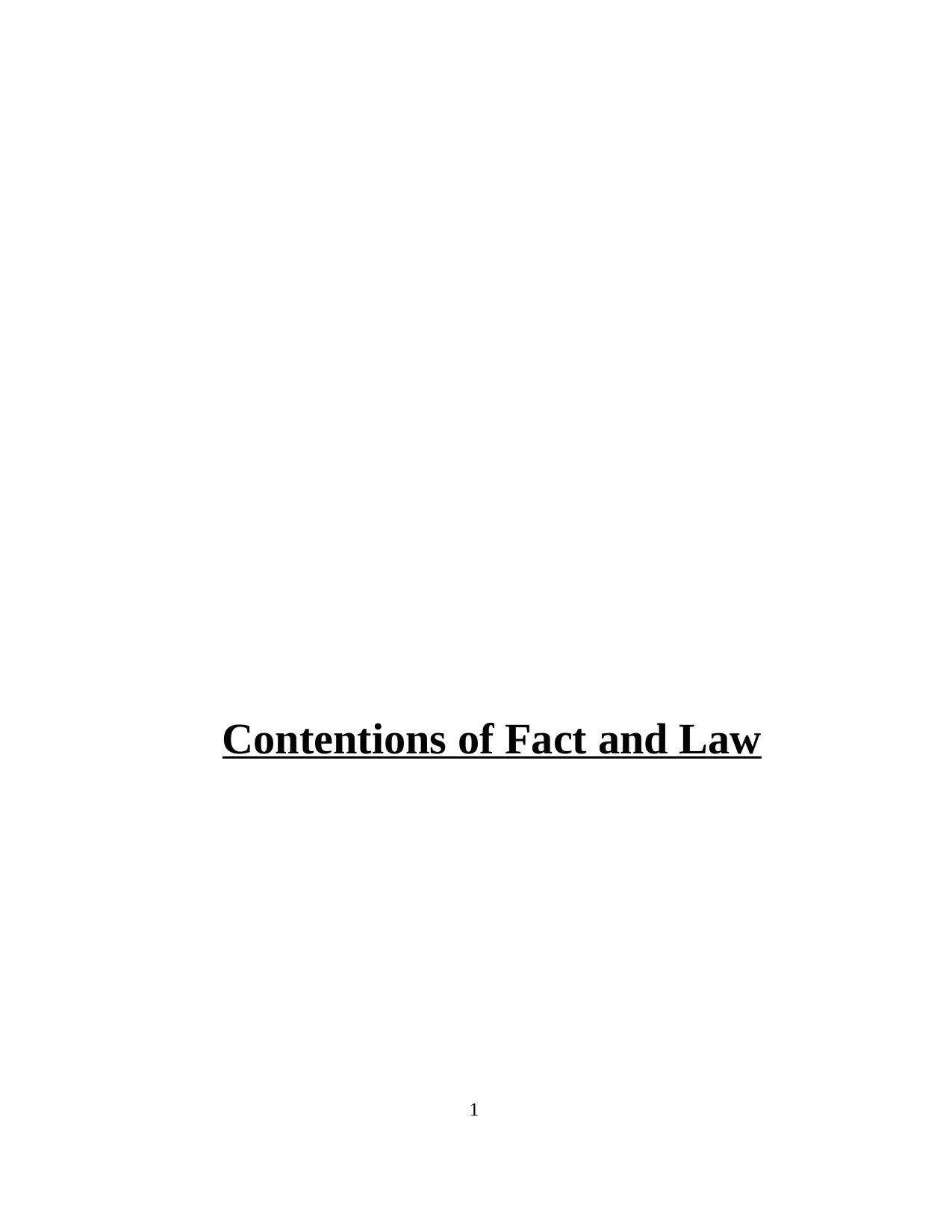
Contentions of Fact and Law
1
1
Paraphrase This Document
Need a fresh take? Get an instant paraphrase of this document with our AI Paraphraser
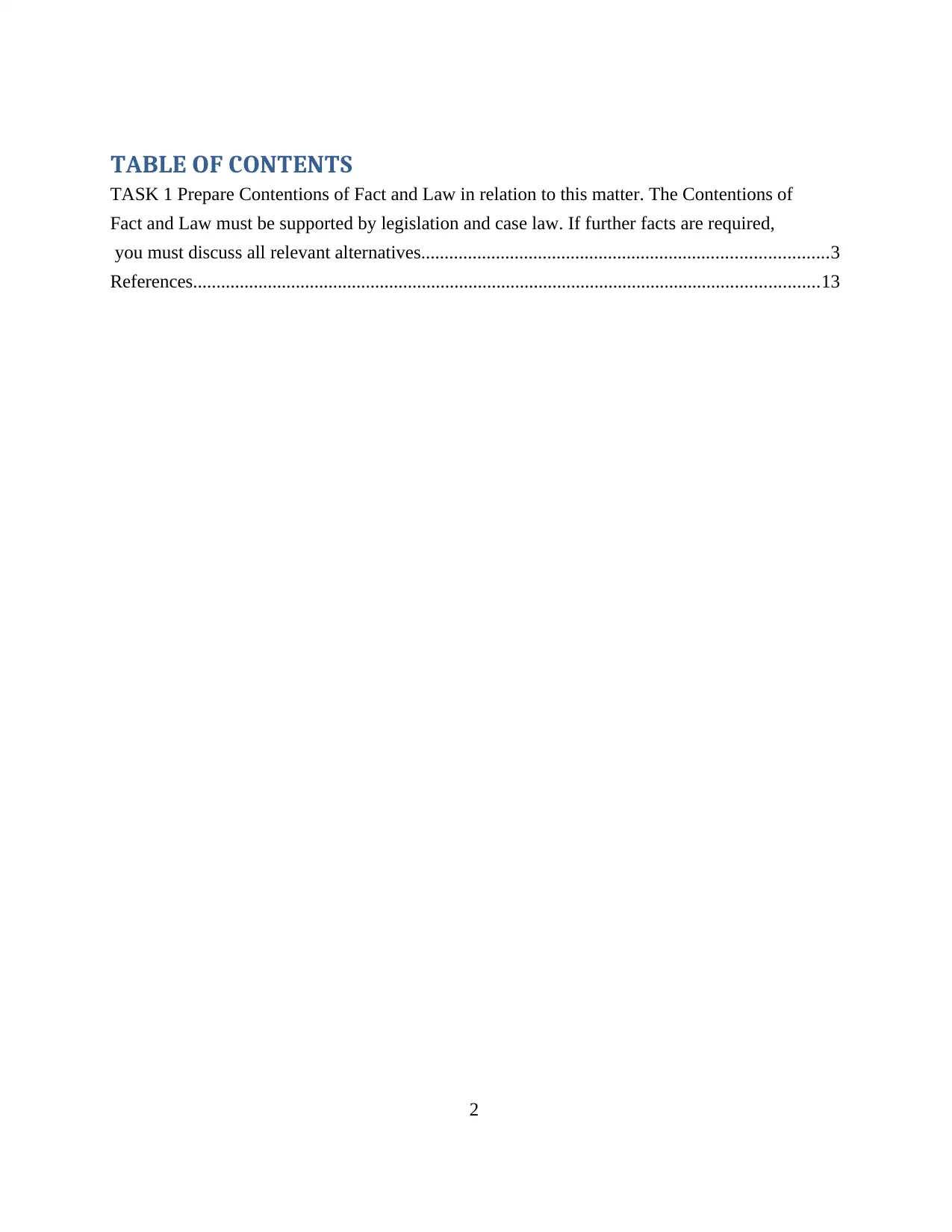
TABLE OF CONTENTS
TASK 1 Prepare Contentions of Fact and Law in relation to this matter. The Contentions of
Fact and Law must be supported by legislation and case law. If further facts are required,
you must discuss all relevant alternatives.......................................................................................3
References......................................................................................................................................13
2
TASK 1 Prepare Contentions of Fact and Law in relation to this matter. The Contentions of
Fact and Law must be supported by legislation and case law. If further facts are required,
you must discuss all relevant alternatives.......................................................................................3
References......................................................................................................................................13
2

TASK 1 PREPARE CONTENTIONS OF FACT AND LAW IN RELATION
TO THIS MATTER. THE CONTENTIONS OF
3
TO THIS MATTER. THE CONTENTIONS OF
3
⊘ This is a preview!⊘
Do you want full access?
Subscribe today to unlock all pages.

Trusted by 1+ million students worldwide

FACT AND LAW MUST BE SUPPORTED BY LEGISLATION AND CASE
LAW. IF FURTHER FACTS ARE REQUIRED,
4
LAW. IF FURTHER FACTS ARE REQUIRED,
4
Paraphrase This Document
Need a fresh take? Get an instant paraphrase of this document with our AI Paraphraser
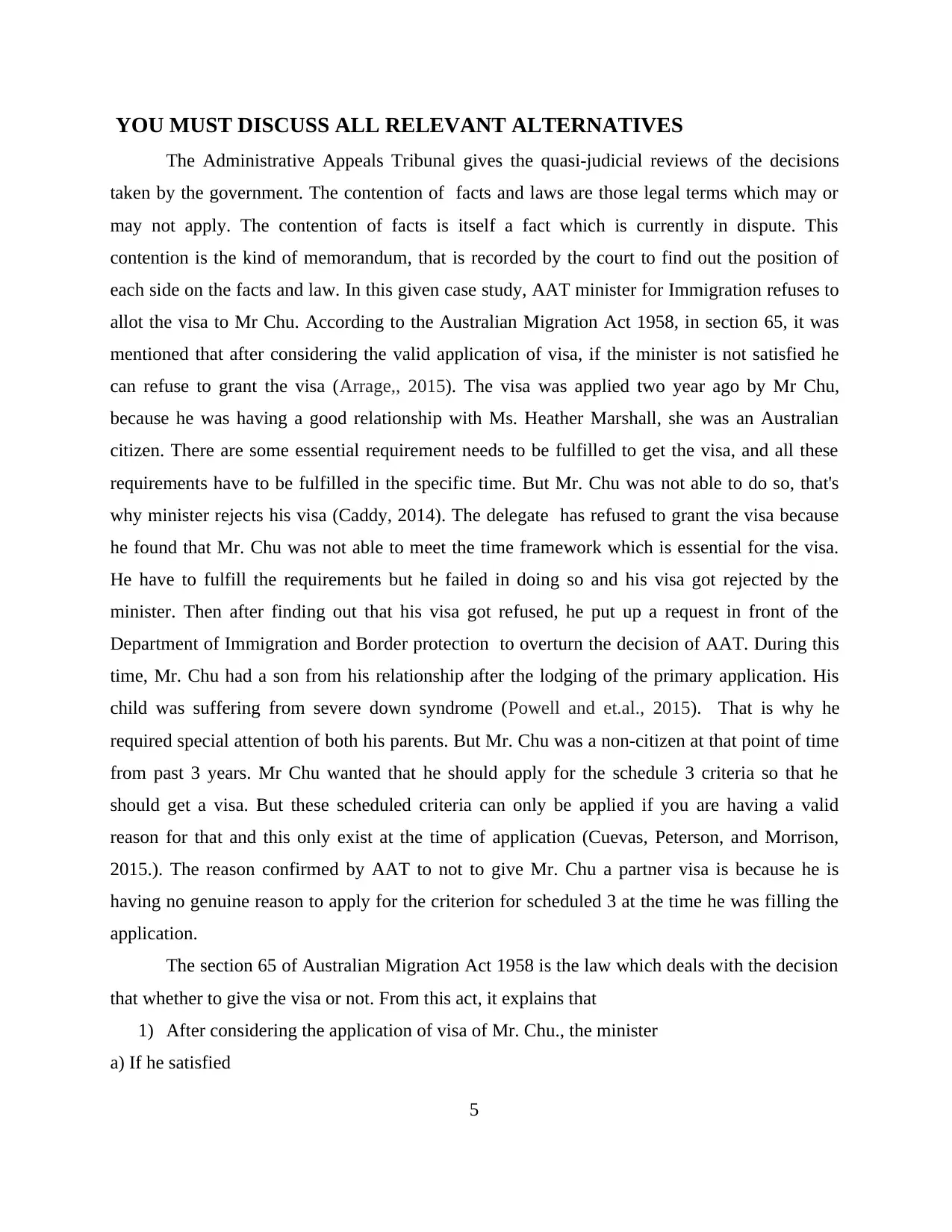
YOU MUST DISCUSS ALL RELEVANT ALTERNATIVES
The Administrative Appeals Tribunal gives the quasi-judicial reviews of the decisions
taken by the government. The contention of facts and laws are those legal terms which may or
may not apply. The contention of facts is itself a fact which is currently in dispute. This
contention is the kind of memorandum, that is recorded by the court to find out the position of
each side on the facts and law. In this given case study, AAT minister for Immigration refuses to
allot the visa to Mr Chu. According to the Australian Migration Act 1958, in section 65, it was
mentioned that after considering the valid application of visa, if the minister is not satisfied he
can refuse to grant the visa (Arrage,, 2015). The visa was applied two year ago by Mr Chu,
because he was having a good relationship with Ms. Heather Marshall, she was an Australian
citizen. There are some essential requirement needs to be fulfilled to get the visa, and all these
requirements have to be fulfilled in the specific time. But Mr. Chu was not able to do so, that's
why minister rejects his visa (Caddy, 2014). The delegate has refused to grant the visa because
he found that Mr. Chu was not able to meet the time framework which is essential for the visa.
He have to fulfill the requirements but he failed in doing so and his visa got rejected by the
minister. Then after finding out that his visa got refused, he put up a request in front of the
Department of Immigration and Border protection to overturn the decision of AAT. During this
time, Mr. Chu had a son from his relationship after the lodging of the primary application. His
child was suffering from severe down syndrome (Powell and et.al., 2015). That is why he
required special attention of both his parents. But Mr. Chu was a non-citizen at that point of time
from past 3 years. Mr Chu wanted that he should apply for the schedule 3 criteria so that he
should get a visa. But these scheduled criteria can only be applied if you are having a valid
reason for that and this only exist at the time of application (Cuevas, Peterson, and Morrison,
2015.). The reason confirmed by AAT to not to give Mr. Chu a partner visa is because he is
having no genuine reason to apply for the criterion for scheduled 3 at the time he was filling the
application.
The section 65 of Australian Migration Act 1958 is the law which deals with the decision
that whether to give the visa or not. From this act, it explains that
1) After considering the application of visa of Mr. Chu., the minister
a) If he satisfied
5
The Administrative Appeals Tribunal gives the quasi-judicial reviews of the decisions
taken by the government. The contention of facts and laws are those legal terms which may or
may not apply. The contention of facts is itself a fact which is currently in dispute. This
contention is the kind of memorandum, that is recorded by the court to find out the position of
each side on the facts and law. In this given case study, AAT minister for Immigration refuses to
allot the visa to Mr Chu. According to the Australian Migration Act 1958, in section 65, it was
mentioned that after considering the valid application of visa, if the minister is not satisfied he
can refuse to grant the visa (Arrage,, 2015). The visa was applied two year ago by Mr Chu,
because he was having a good relationship with Ms. Heather Marshall, she was an Australian
citizen. There are some essential requirement needs to be fulfilled to get the visa, and all these
requirements have to be fulfilled in the specific time. But Mr. Chu was not able to do so, that's
why minister rejects his visa (Caddy, 2014). The delegate has refused to grant the visa because
he found that Mr. Chu was not able to meet the time framework which is essential for the visa.
He have to fulfill the requirements but he failed in doing so and his visa got rejected by the
minister. Then after finding out that his visa got refused, he put up a request in front of the
Department of Immigration and Border protection to overturn the decision of AAT. During this
time, Mr. Chu had a son from his relationship after the lodging of the primary application. His
child was suffering from severe down syndrome (Powell and et.al., 2015). That is why he
required special attention of both his parents. But Mr. Chu was a non-citizen at that point of time
from past 3 years. Mr Chu wanted that he should apply for the schedule 3 criteria so that he
should get a visa. But these scheduled criteria can only be applied if you are having a valid
reason for that and this only exist at the time of application (Cuevas, Peterson, and Morrison,
2015.). The reason confirmed by AAT to not to give Mr. Chu a partner visa is because he is
having no genuine reason to apply for the criterion for scheduled 3 at the time he was filling the
application.
The section 65 of Australian Migration Act 1958 is the law which deals with the decision
that whether to give the visa or not. From this act, it explains that
1) After considering the application of visa of Mr. Chu., the minister
a) If he satisfied
5
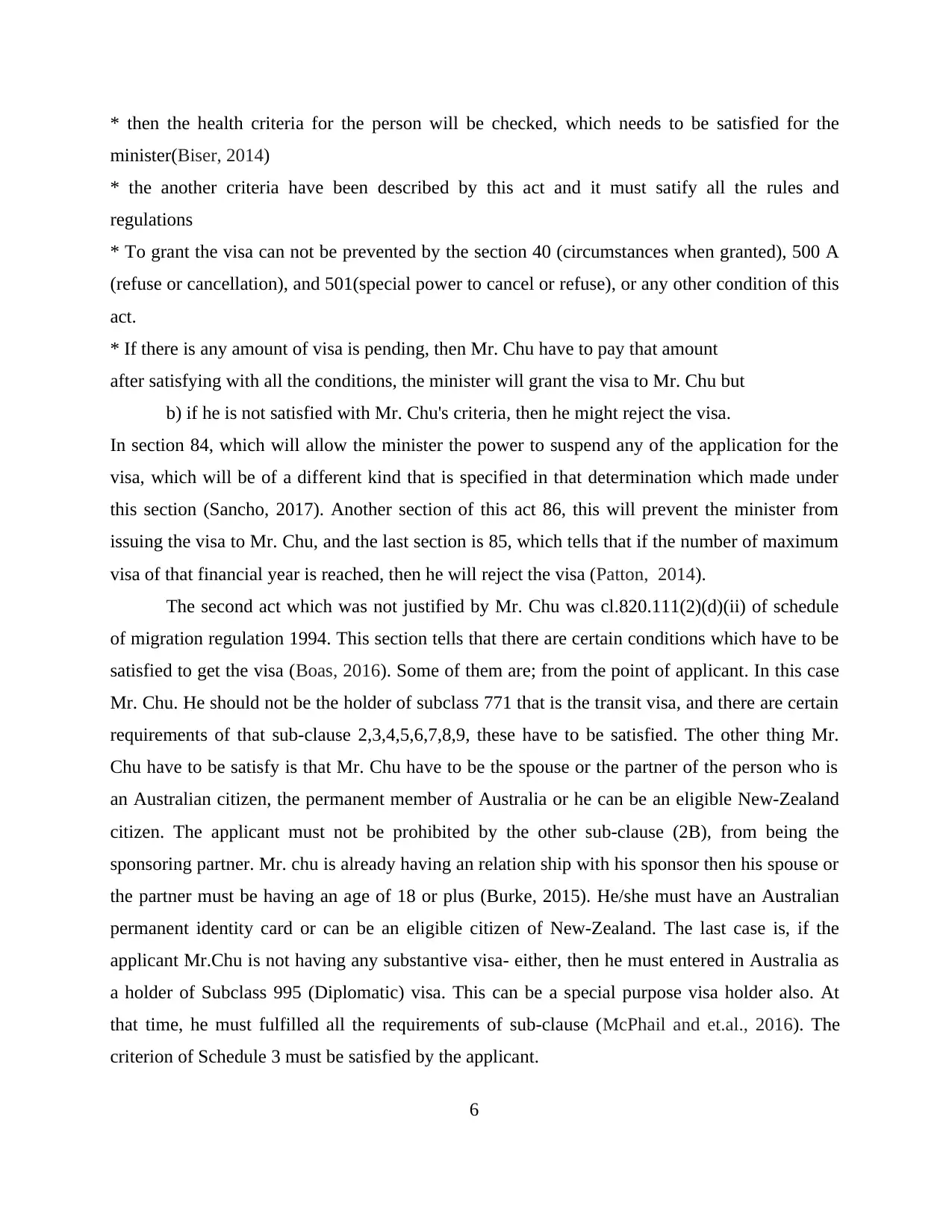
* then the health criteria for the person will be checked, which needs to be satisfied for the
minister(Biser, 2014)
* the another criteria have been described by this act and it must satify all the rules and
regulations
* To grant the visa can not be prevented by the section 40 (circumstances when granted), 500 A
(refuse or cancellation), and 501(special power to cancel or refuse), or any other condition of this
act.
* If there is any amount of visa is pending, then Mr. Chu have to pay that amount
after satisfying with all the conditions, the minister will grant the visa to Mr. Chu but
b) if he is not satisfied with Mr. Chu's criteria, then he might reject the visa.
In section 84, which will allow the minister the power to suspend any of the application for the
visa, which will be of a different kind that is specified in that determination which made under
this section (Sancho, 2017). Another section of this act 86, this will prevent the minister from
issuing the visa to Mr. Chu, and the last section is 85, which tells that if the number of maximum
visa of that financial year is reached, then he will reject the visa (Patton, 2014).
The second act which was not justified by Mr. Chu was cl.820.111(2)(d)(ii) of schedule
of migration regulation 1994. This section tells that there are certain conditions which have to be
satisfied to get the visa (Boas, 2016). Some of them are; from the point of applicant. In this case
Mr. Chu. He should not be the holder of subclass 771 that is the transit visa, and there are certain
requirements of that sub-clause 2,3,4,5,6,7,8,9, these have to be satisfied. The other thing Mr.
Chu have to be satisfy is that Mr. Chu have to be the spouse or the partner of the person who is
an Australian citizen, the permanent member of Australia or he can be an eligible New-Zealand
citizen. The applicant must not be prohibited by the other sub-clause (2B), from being the
sponsoring partner. Mr. chu is already having an relation ship with his sponsor then his spouse or
the partner must be having an age of 18 or plus (Burke, 2015). He/she must have an Australian
permanent identity card or can be an eligible citizen of New-Zealand. The last case is, if the
applicant Mr.Chu is not having any substantive visa- either, then he must entered in Australia as
a holder of Subclass 995 (Diplomatic) visa. This can be a special purpose visa holder also. At
that time, he must fulfilled all the requirements of sub-clause (McPhail and et.al., 2016). The
criterion of Schedule 3 must be satisfied by the applicant.
6
minister(Biser, 2014)
* the another criteria have been described by this act and it must satify all the rules and
regulations
* To grant the visa can not be prevented by the section 40 (circumstances when granted), 500 A
(refuse or cancellation), and 501(special power to cancel or refuse), or any other condition of this
act.
* If there is any amount of visa is pending, then Mr. Chu have to pay that amount
after satisfying with all the conditions, the minister will grant the visa to Mr. Chu but
b) if he is not satisfied with Mr. Chu's criteria, then he might reject the visa.
In section 84, which will allow the minister the power to suspend any of the application for the
visa, which will be of a different kind that is specified in that determination which made under
this section (Sancho, 2017). Another section of this act 86, this will prevent the minister from
issuing the visa to Mr. Chu, and the last section is 85, which tells that if the number of maximum
visa of that financial year is reached, then he will reject the visa (Patton, 2014).
The second act which was not justified by Mr. Chu was cl.820.111(2)(d)(ii) of schedule
of migration regulation 1994. This section tells that there are certain conditions which have to be
satisfied to get the visa (Boas, 2016). Some of them are; from the point of applicant. In this case
Mr. Chu. He should not be the holder of subclass 771 that is the transit visa, and there are certain
requirements of that sub-clause 2,3,4,5,6,7,8,9, these have to be satisfied. The other thing Mr.
Chu have to be satisfy is that Mr. Chu have to be the spouse or the partner of the person who is
an Australian citizen, the permanent member of Australia or he can be an eligible New-Zealand
citizen. The applicant must not be prohibited by the other sub-clause (2B), from being the
sponsoring partner. Mr. chu is already having an relation ship with his sponsor then his spouse or
the partner must be having an age of 18 or plus (Burke, 2015). He/she must have an Australian
permanent identity card or can be an eligible citizen of New-Zealand. The last case is, if the
applicant Mr.Chu is not having any substantive visa- either, then he must entered in Australia as
a holder of Subclass 995 (Diplomatic) visa. This can be a special purpose visa holder also. At
that time, he must fulfilled all the requirements of sub-clause (McPhail and et.al., 2016). The
criterion of Schedule 3 must be satisfied by the applicant.
6
⊘ This is a preview!⊘
Do you want full access?
Subscribe today to unlock all pages.

Trusted by 1+ million students worldwide
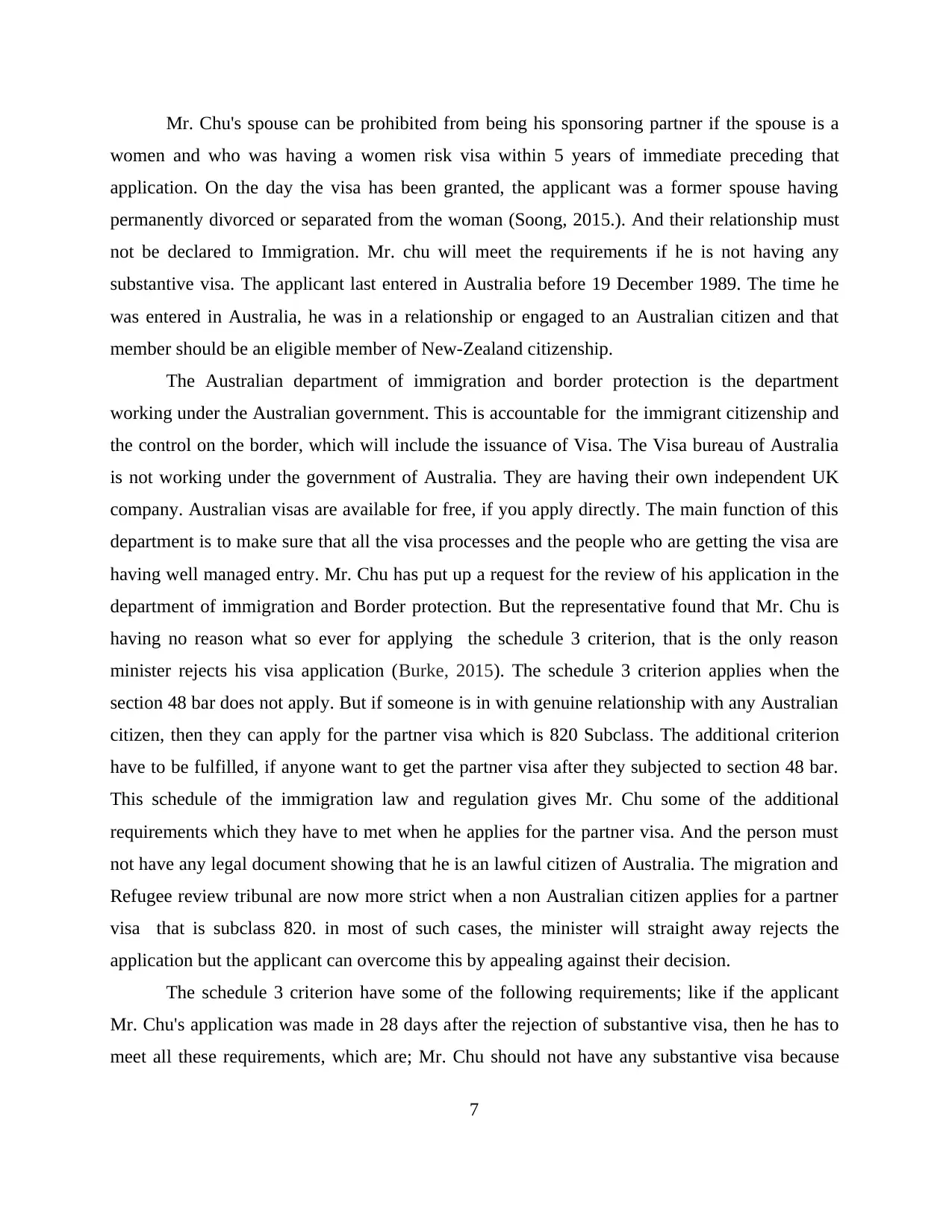
Mr. Chu's spouse can be prohibited from being his sponsoring partner if the spouse is a
women and who was having a women risk visa within 5 years of immediate preceding that
application. On the day the visa has been granted, the applicant was a former spouse having
permanently divorced or separated from the woman (Soong, 2015.). And their relationship must
not be declared to Immigration. Mr. chu will meet the requirements if he is not having any
substantive visa. The applicant last entered in Australia before 19 December 1989. The time he
was entered in Australia, he was in a relationship or engaged to an Australian citizen and that
member should be an eligible member of New-Zealand citizenship.
The Australian department of immigration and border protection is the department
working under the Australian government. This is accountable for the immigrant citizenship and
the control on the border, which will include the issuance of Visa. The Visa bureau of Australia
is not working under the government of Australia. They are having their own independent UK
company. Australian visas are available for free, if you apply directly. The main function of this
department is to make sure that all the visa processes and the people who are getting the visa are
having well managed entry. Mr. Chu has put up a request for the review of his application in the
department of immigration and Border protection. But the representative found that Mr. Chu is
having no reason what so ever for applying the schedule 3 criterion, that is the only reason
minister rejects his visa application (Burke, 2015). The schedule 3 criterion applies when the
section 48 bar does not apply. But if someone is in with genuine relationship with any Australian
citizen, then they can apply for the partner visa which is 820 Subclass. The additional criterion
have to be fulfilled, if anyone want to get the partner visa after they subjected to section 48 bar.
This schedule of the immigration law and regulation gives Mr. Chu some of the additional
requirements which they have to met when he applies for the partner visa. And the person must
not have any legal document showing that he is an lawful citizen of Australia. The migration and
Refugee review tribunal are now more strict when a non Australian citizen applies for a partner
visa that is subclass 820. in most of such cases, the minister will straight away rejects the
application but the applicant can overcome this by appealing against their decision.
The schedule 3 criterion have some of the following requirements; like if the applicant
Mr. Chu's application was made in 28 days after the rejection of substantive visa, then he has to
meet all these requirements, which are; Mr. Chu should not have any substantive visa because
7
women and who was having a women risk visa within 5 years of immediate preceding that
application. On the day the visa has been granted, the applicant was a former spouse having
permanently divorced or separated from the woman (Soong, 2015.). And their relationship must
not be declared to Immigration. Mr. chu will meet the requirements if he is not having any
substantive visa. The applicant last entered in Australia before 19 December 1989. The time he
was entered in Australia, he was in a relationship or engaged to an Australian citizen and that
member should be an eligible member of New-Zealand citizenship.
The Australian department of immigration and border protection is the department
working under the Australian government. This is accountable for the immigrant citizenship and
the control on the border, which will include the issuance of Visa. The Visa bureau of Australia
is not working under the government of Australia. They are having their own independent UK
company. Australian visas are available for free, if you apply directly. The main function of this
department is to make sure that all the visa processes and the people who are getting the visa are
having well managed entry. Mr. Chu has put up a request for the review of his application in the
department of immigration and Border protection. But the representative found that Mr. Chu is
having no reason what so ever for applying the schedule 3 criterion, that is the only reason
minister rejects his visa application (Burke, 2015). The schedule 3 criterion applies when the
section 48 bar does not apply. But if someone is in with genuine relationship with any Australian
citizen, then they can apply for the partner visa which is 820 Subclass. The additional criterion
have to be fulfilled, if anyone want to get the partner visa after they subjected to section 48 bar.
This schedule of the immigration law and regulation gives Mr. Chu some of the additional
requirements which they have to met when he applies for the partner visa. And the person must
not have any legal document showing that he is an lawful citizen of Australia. The migration and
Refugee review tribunal are now more strict when a non Australian citizen applies for a partner
visa that is subclass 820. in most of such cases, the minister will straight away rejects the
application but the applicant can overcome this by appealing against their decision.
The schedule 3 criterion have some of the following requirements; like if the applicant
Mr. Chu's application was made in 28 days after the rejection of substantive visa, then he has to
meet all these requirements, which are; Mr. Chu should not have any substantive visa because
7
Paraphrase This Document
Need a fresh take? Get an instant paraphrase of this document with our AI Paraphraser
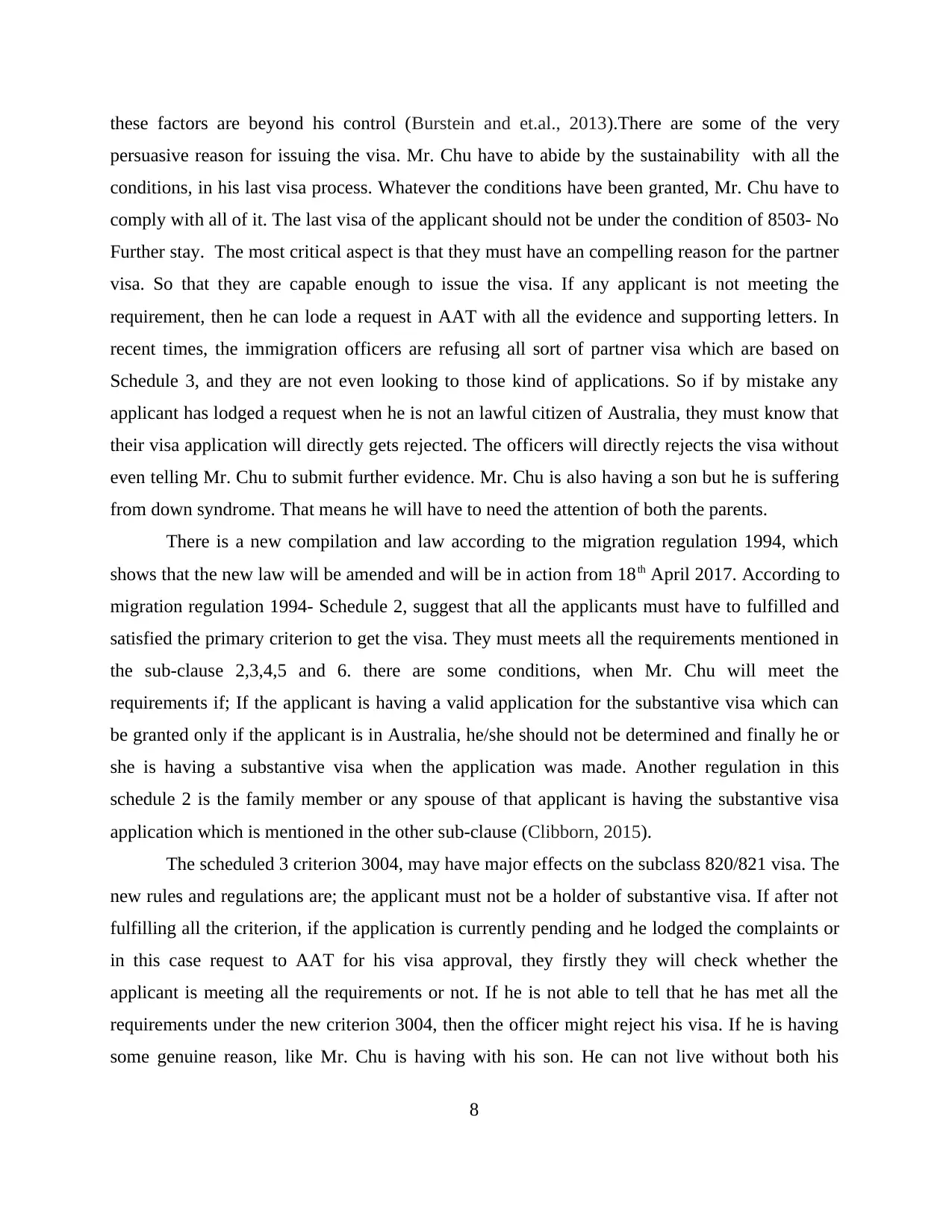
these factors are beyond his control (Burstein and et.al., 2013).There are some of the very
persuasive reason for issuing the visa. Mr. Chu have to abide by the sustainability with all the
conditions, in his last visa process. Whatever the conditions have been granted, Mr. Chu have to
comply with all of it. The last visa of the applicant should not be under the condition of 8503- No
Further stay. The most critical aspect is that they must have an compelling reason for the partner
visa. So that they are capable enough to issue the visa. If any applicant is not meeting the
requirement, then he can lode a request in AAT with all the evidence and supporting letters. In
recent times, the immigration officers are refusing all sort of partner visa which are based on
Schedule 3, and they are not even looking to those kind of applications. So if by mistake any
applicant has lodged a request when he is not an lawful citizen of Australia, they must know that
their visa application will directly gets rejected. The officers will directly rejects the visa without
even telling Mr. Chu to submit further evidence. Mr. Chu is also having a son but he is suffering
from down syndrome. That means he will have to need the attention of both the parents.
There is a new compilation and law according to the migration regulation 1994, which
shows that the new law will be amended and will be in action from 18th April 2017. According to
migration regulation 1994- Schedule 2, suggest that all the applicants must have to fulfilled and
satisfied the primary criterion to get the visa. They must meets all the requirements mentioned in
the sub-clause 2,3,4,5 and 6. there are some conditions, when Mr. Chu will meet the
requirements if; If the applicant is having a valid application for the substantive visa which can
be granted only if the applicant is in Australia, he/she should not be determined and finally he or
she is having a substantive visa when the application was made. Another regulation in this
schedule 2 is the family member or any spouse of that applicant is having the substantive visa
application which is mentioned in the other sub-clause (Clibborn, 2015).
The scheduled 3 criterion 3004, may have major effects on the subclass 820/821 visa. The
new rules and regulations are; the applicant must not be a holder of substantive visa. If after not
fulfilling all the criterion, if the application is currently pending and he lodged the complaints or
in this case request to AAT for his visa approval, they firstly they will check whether the
applicant is meeting all the requirements or not. If he is not able to tell that he has met all the
requirements under the new criterion 3004, then the officer might reject his visa. If he is having
some genuine reason, like Mr. Chu is having with his son. He can not live without both his
8
persuasive reason for issuing the visa. Mr. Chu have to abide by the sustainability with all the
conditions, in his last visa process. Whatever the conditions have been granted, Mr. Chu have to
comply with all of it. The last visa of the applicant should not be under the condition of 8503- No
Further stay. The most critical aspect is that they must have an compelling reason for the partner
visa. So that they are capable enough to issue the visa. If any applicant is not meeting the
requirement, then he can lode a request in AAT with all the evidence and supporting letters. In
recent times, the immigration officers are refusing all sort of partner visa which are based on
Schedule 3, and they are not even looking to those kind of applications. So if by mistake any
applicant has lodged a request when he is not an lawful citizen of Australia, they must know that
their visa application will directly gets rejected. The officers will directly rejects the visa without
even telling Mr. Chu to submit further evidence. Mr. Chu is also having a son but he is suffering
from down syndrome. That means he will have to need the attention of both the parents.
There is a new compilation and law according to the migration regulation 1994, which
shows that the new law will be amended and will be in action from 18th April 2017. According to
migration regulation 1994- Schedule 2, suggest that all the applicants must have to fulfilled and
satisfied the primary criterion to get the visa. They must meets all the requirements mentioned in
the sub-clause 2,3,4,5 and 6. there are some conditions, when Mr. Chu will meet the
requirements if; If the applicant is having a valid application for the substantive visa which can
be granted only if the applicant is in Australia, he/she should not be determined and finally he or
she is having a substantive visa when the application was made. Another regulation in this
schedule 2 is the family member or any spouse of that applicant is having the substantive visa
application which is mentioned in the other sub-clause (Clibborn, 2015).
The scheduled 3 criterion 3004, may have major effects on the subclass 820/821 visa. The
new rules and regulations are; the applicant must not be a holder of substantive visa. If after not
fulfilling all the criterion, if the application is currently pending and he lodged the complaints or
in this case request to AAT for his visa approval, they firstly they will check whether the
applicant is meeting all the requirements or not. If he is not able to tell that he has met all the
requirements under the new criterion 3004, then the officer might reject his visa. If he is having
some genuine reason, like Mr. Chu is having with his son. He can not live without both his
8
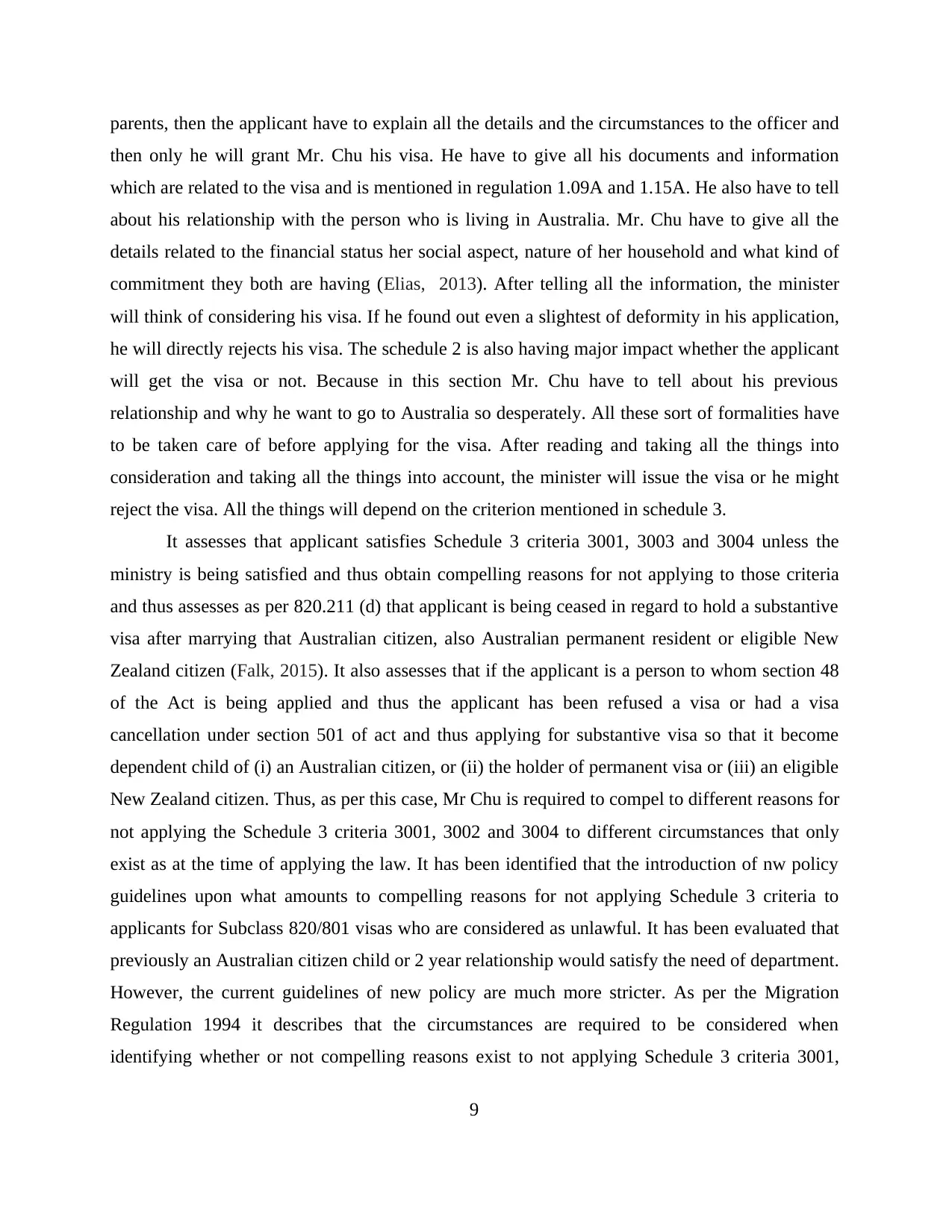
parents, then the applicant have to explain all the details and the circumstances to the officer and
then only he will grant Mr. Chu his visa. He have to give all his documents and information
which are related to the visa and is mentioned in regulation 1.09A and 1.15A. He also have to tell
about his relationship with the person who is living in Australia. Mr. Chu have to give all the
details related to the financial status her social aspect, nature of her household and what kind of
commitment they both are having (Elias, 2013). After telling all the information, the minister
will think of considering his visa. If he found out even a slightest of deformity in his application,
he will directly rejects his visa. The schedule 2 is also having major impact whether the applicant
will get the visa or not. Because in this section Mr. Chu have to tell about his previous
relationship and why he want to go to Australia so desperately. All these sort of formalities have
to be taken care of before applying for the visa. After reading and taking all the things into
consideration and taking all the things into account, the minister will issue the visa or he might
reject the visa. All the things will depend on the criterion mentioned in schedule 3.
It assesses that applicant satisfies Schedule 3 criteria 3001, 3003 and 3004 unless the
ministry is being satisfied and thus obtain compelling reasons for not applying to those criteria
and thus assesses as per 820.211 (d) that applicant is being ceased in regard to hold a substantive
visa after marrying that Australian citizen, also Australian permanent resident or eligible New
Zealand citizen (Falk, 2015). It also assesses that if the applicant is a person to whom section 48
of the Act is being applied and thus the applicant has been refused a visa or had a visa
cancellation under section 501 of act and thus applying for substantive visa so that it become
dependent child of (i) an Australian citizen, or (ii) the holder of permanent visa or (iii) an eligible
New Zealand citizen. Thus, as per this case, Mr Chu is required to compel to different reasons for
not applying the Schedule 3 criteria 3001, 3002 and 3004 to different circumstances that only
exist as at the time of applying the law. It has been identified that the introduction of nw policy
guidelines upon what amounts to compelling reasons for not applying Schedule 3 criteria to
applicants for Subclass 820/801 visas who are considered as unlawful. It has been evaluated that
previously an Australian citizen child or 2 year relationship would satisfy the need of department.
However, the current guidelines of new policy are much more stricter. As per the Migration
Regulation 1994 it describes that the circumstances are required to be considered when
identifying whether or not compelling reasons exist to not applying Schedule 3 criteria 3001,
9
then only he will grant Mr. Chu his visa. He have to give all his documents and information
which are related to the visa and is mentioned in regulation 1.09A and 1.15A. He also have to tell
about his relationship with the person who is living in Australia. Mr. Chu have to give all the
details related to the financial status her social aspect, nature of her household and what kind of
commitment they both are having (Elias, 2013). After telling all the information, the minister
will think of considering his visa. If he found out even a slightest of deformity in his application,
he will directly rejects his visa. The schedule 2 is also having major impact whether the applicant
will get the visa or not. Because in this section Mr. Chu have to tell about his previous
relationship and why he want to go to Australia so desperately. All these sort of formalities have
to be taken care of before applying for the visa. After reading and taking all the things into
consideration and taking all the things into account, the minister will issue the visa or he might
reject the visa. All the things will depend on the criterion mentioned in schedule 3.
It assesses that applicant satisfies Schedule 3 criteria 3001, 3003 and 3004 unless the
ministry is being satisfied and thus obtain compelling reasons for not applying to those criteria
and thus assesses as per 820.211 (d) that applicant is being ceased in regard to hold a substantive
visa after marrying that Australian citizen, also Australian permanent resident or eligible New
Zealand citizen (Falk, 2015). It also assesses that if the applicant is a person to whom section 48
of the Act is being applied and thus the applicant has been refused a visa or had a visa
cancellation under section 501 of act and thus applying for substantive visa so that it become
dependent child of (i) an Australian citizen, or (ii) the holder of permanent visa or (iii) an eligible
New Zealand citizen. Thus, as per this case, Mr Chu is required to compel to different reasons for
not applying the Schedule 3 criteria 3001, 3002 and 3004 to different circumstances that only
exist as at the time of applying the law. It has been identified that the introduction of nw policy
guidelines upon what amounts to compelling reasons for not applying Schedule 3 criteria to
applicants for Subclass 820/801 visas who are considered as unlawful. It has been evaluated that
previously an Australian citizen child or 2 year relationship would satisfy the need of department.
However, the current guidelines of new policy are much more stricter. As per the Migration
Regulation 1994 it describes that the circumstances are required to be considered when
identifying whether or not compelling reasons exist to not applying Schedule 3 criteria 3001,
9
⊘ This is a preview!⊘
Do you want full access?
Subscribe today to unlock all pages.

Trusted by 1+ million students worldwide
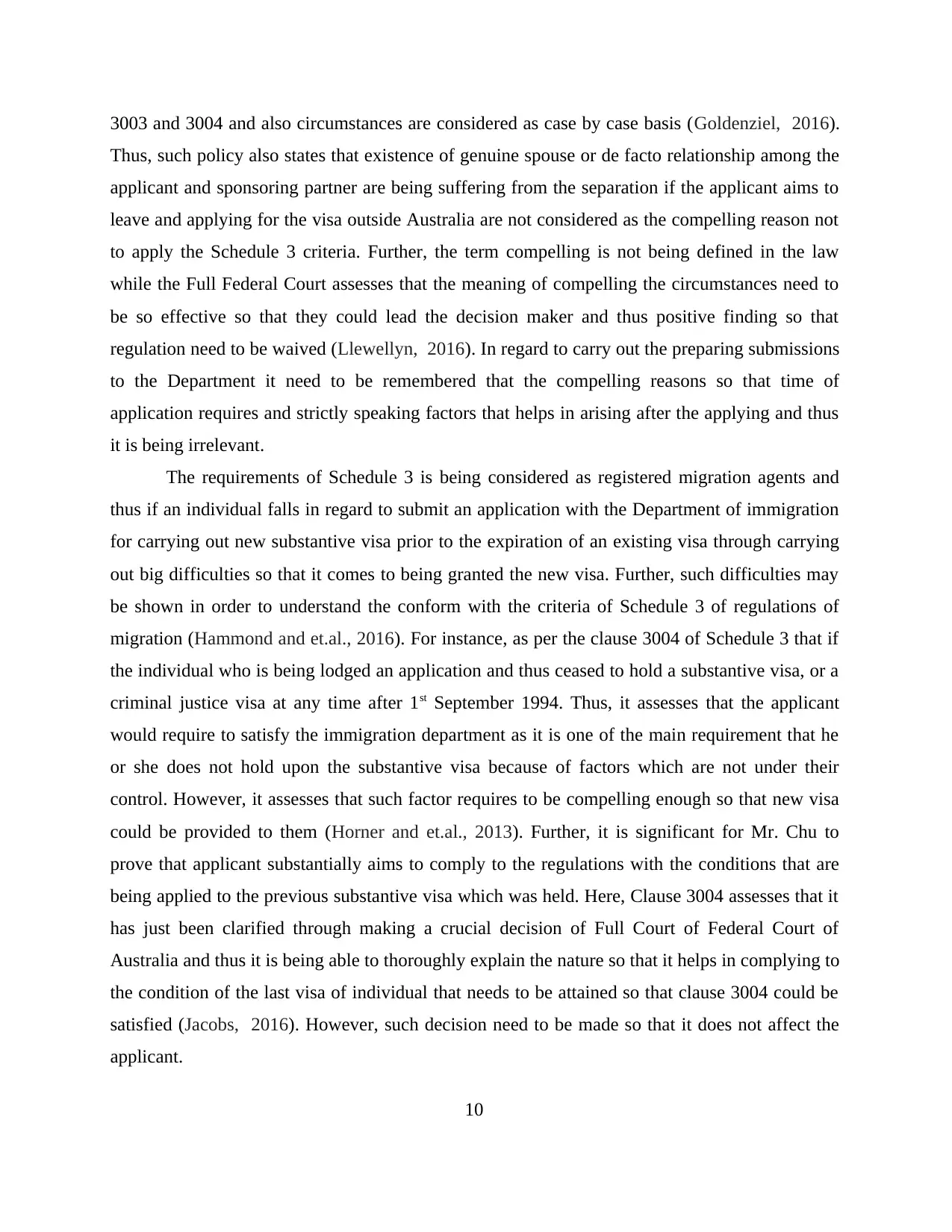
3003 and 3004 and also circumstances are considered as case by case basis (Goldenziel, 2016).
Thus, such policy also states that existence of genuine spouse or de facto relationship among the
applicant and sponsoring partner are being suffering from the separation if the applicant aims to
leave and applying for the visa outside Australia are not considered as the compelling reason not
to apply the Schedule 3 criteria. Further, the term compelling is not being defined in the law
while the Full Federal Court assesses that the meaning of compelling the circumstances need to
be so effective so that they could lead the decision maker and thus positive finding so that
regulation need to be waived (Llewellyn, 2016). In regard to carry out the preparing submissions
to the Department it need to be remembered that the compelling reasons so that time of
application requires and strictly speaking factors that helps in arising after the applying and thus
it is being irrelevant.
The requirements of Schedule 3 is being considered as registered migration agents and
thus if an individual falls in regard to submit an application with the Department of immigration
for carrying out new substantive visa prior to the expiration of an existing visa through carrying
out big difficulties so that it comes to being granted the new visa. Further, such difficulties may
be shown in order to understand the conform with the criteria of Schedule 3 of regulations of
migration (Hammond and et.al., 2016). For instance, as per the clause 3004 of Schedule 3 that if
the individual who is being lodged an application and thus ceased to hold a substantive visa, or a
criminal justice visa at any time after 1st September 1994. Thus, it assesses that the applicant
would require to satisfy the immigration department as it is one of the main requirement that he
or she does not hold upon the substantive visa because of factors which are not under their
control. However, it assesses that such factor requires to be compelling enough so that new visa
could be provided to them (Horner and et.al., 2013). Further, it is significant for Mr. Chu to
prove that applicant substantially aims to comply to the regulations with the conditions that are
being applied to the previous substantive visa which was held. Here, Clause 3004 assesses that it
has just been clarified through making a crucial decision of Full Court of Federal Court of
Australia and thus it is being able to thoroughly explain the nature so that it helps in complying to
the condition of the last visa of individual that needs to be attained so that clause 3004 could be
satisfied (Jacobs, 2016). However, such decision need to be made so that it does not affect the
applicant.
10
Thus, such policy also states that existence of genuine spouse or de facto relationship among the
applicant and sponsoring partner are being suffering from the separation if the applicant aims to
leave and applying for the visa outside Australia are not considered as the compelling reason not
to apply the Schedule 3 criteria. Further, the term compelling is not being defined in the law
while the Full Federal Court assesses that the meaning of compelling the circumstances need to
be so effective so that they could lead the decision maker and thus positive finding so that
regulation need to be waived (Llewellyn, 2016). In regard to carry out the preparing submissions
to the Department it need to be remembered that the compelling reasons so that time of
application requires and strictly speaking factors that helps in arising after the applying and thus
it is being irrelevant.
The requirements of Schedule 3 is being considered as registered migration agents and
thus if an individual falls in regard to submit an application with the Department of immigration
for carrying out new substantive visa prior to the expiration of an existing visa through carrying
out big difficulties so that it comes to being granted the new visa. Further, such difficulties may
be shown in order to understand the conform with the criteria of Schedule 3 of regulations of
migration (Hammond and et.al., 2016). For instance, as per the clause 3004 of Schedule 3 that if
the individual who is being lodged an application and thus ceased to hold a substantive visa, or a
criminal justice visa at any time after 1st September 1994. Thus, it assesses that the applicant
would require to satisfy the immigration department as it is one of the main requirement that he
or she does not hold upon the substantive visa because of factors which are not under their
control. However, it assesses that such factor requires to be compelling enough so that new visa
could be provided to them (Horner and et.al., 2013). Further, it is significant for Mr. Chu to
prove that applicant substantially aims to comply to the regulations with the conditions that are
being applied to the previous substantive visa which was held. Here, Clause 3004 assesses that it
has just been clarified through making a crucial decision of Full Court of Federal Court of
Australia and thus it is being able to thoroughly explain the nature so that it helps in complying to
the condition of the last visa of individual that needs to be attained so that clause 3004 could be
satisfied (Jacobs, 2016). However, such decision need to be made so that it does not affect the
applicant.
10
Paraphrase This Document
Need a fresh take? Get an instant paraphrase of this document with our AI Paraphraser

Here, it assesses that through reviewing Migration Review Tribunal (MRT) needs to be
considered as refusal of the application being done by the officer so that the applicant are
required to be satisfy clause 3004 (e) (ii), as it identifies that substantially complying to the
conditions it results in integrating into the visa of student (Knapp and et.al., 2016). Through
carrying out the interpretation it assesses that it was rejected by the Full Court and thus it is being
stood in order to clause 3004 then each and every one of conditions should be stipulated within
previous visa as it is not being met. Also, the court determines that it was appropriate because of
different conditions of visas that need to be served and directed in relation to fulfill the number of
purposes. However, it is being indeed so that desired actions could be attained (Ramcharan,
2014).
Through applying the partner visa applicants it could be considered that as per the Federal
Court of Australia decision it could be sharply practice the application of Schedule 3 so that
Migration regulation sets out in relation to meet the criteria and thus satisfy the applicants at the
time of identifying the partner visa and grant the same (Rogers, 2013). As per the clause 820.211
(2) (d) (ii) it considers that allowing unlawful to non citizens means who does not hold the
substantive visa in regard to regularize their status if that compels reasons exist. Further, the
catch that comes within the form that the different section should not be unlawful as it involves
waiver provision that recognizes that hardship can result it an unlawful non citizen is being
forced to leave the nation. However, the decision that means for visa applicants is being in a
similar situation to the applicant who is unlawful applying for the visa for partner. Hence, such
decision is being considered as far more sympathetic so that visa applicants is being developed in
relation to the Schedule 3 so that it is being applied to other applicants as well (Smollar, 2014).
Here, decision is being made in regard to review with the exception of certain oral
decisions, a written statement of decision and also reasons are being prepared and provided to the
Department of Immigration and Border Protection. Administrative Appeal Tribunal helps in
providing an independent review of different range of decision so that different decision could be
made (Von Glahn and Taulbee, 2015). In the present case, Mr. Chu application is being refused
for Partner (Temporary) (Class UK) visa for Malaysian citizen and thus here AAT is required to
undertake effective decision so that it does not affect Mr. Chu as well as abide the laws and
regulations.
11
considered as refusal of the application being done by the officer so that the applicant are
required to be satisfy clause 3004 (e) (ii), as it identifies that substantially complying to the
conditions it results in integrating into the visa of student (Knapp and et.al., 2016). Through
carrying out the interpretation it assesses that it was rejected by the Full Court and thus it is being
stood in order to clause 3004 then each and every one of conditions should be stipulated within
previous visa as it is not being met. Also, the court determines that it was appropriate because of
different conditions of visas that need to be served and directed in relation to fulfill the number of
purposes. However, it is being indeed so that desired actions could be attained (Ramcharan,
2014).
Through applying the partner visa applicants it could be considered that as per the Federal
Court of Australia decision it could be sharply practice the application of Schedule 3 so that
Migration regulation sets out in relation to meet the criteria and thus satisfy the applicants at the
time of identifying the partner visa and grant the same (Rogers, 2013). As per the clause 820.211
(2) (d) (ii) it considers that allowing unlawful to non citizens means who does not hold the
substantive visa in regard to regularize their status if that compels reasons exist. Further, the
catch that comes within the form that the different section should not be unlawful as it involves
waiver provision that recognizes that hardship can result it an unlawful non citizen is being
forced to leave the nation. However, the decision that means for visa applicants is being in a
similar situation to the applicant who is unlawful applying for the visa for partner. Hence, such
decision is being considered as far more sympathetic so that visa applicants is being developed in
relation to the Schedule 3 so that it is being applied to other applicants as well (Smollar, 2014).
Here, decision is being made in regard to review with the exception of certain oral
decisions, a written statement of decision and also reasons are being prepared and provided to the
Department of Immigration and Border Protection. Administrative Appeal Tribunal helps in
providing an independent review of different range of decision so that different decision could be
made (Von Glahn and Taulbee, 2015). In the present case, Mr. Chu application is being refused
for Partner (Temporary) (Class UK) visa for Malaysian citizen and thus here AAT is required to
undertake effective decision so that it does not affect Mr. Chu as well as abide the laws and
regulations.
11
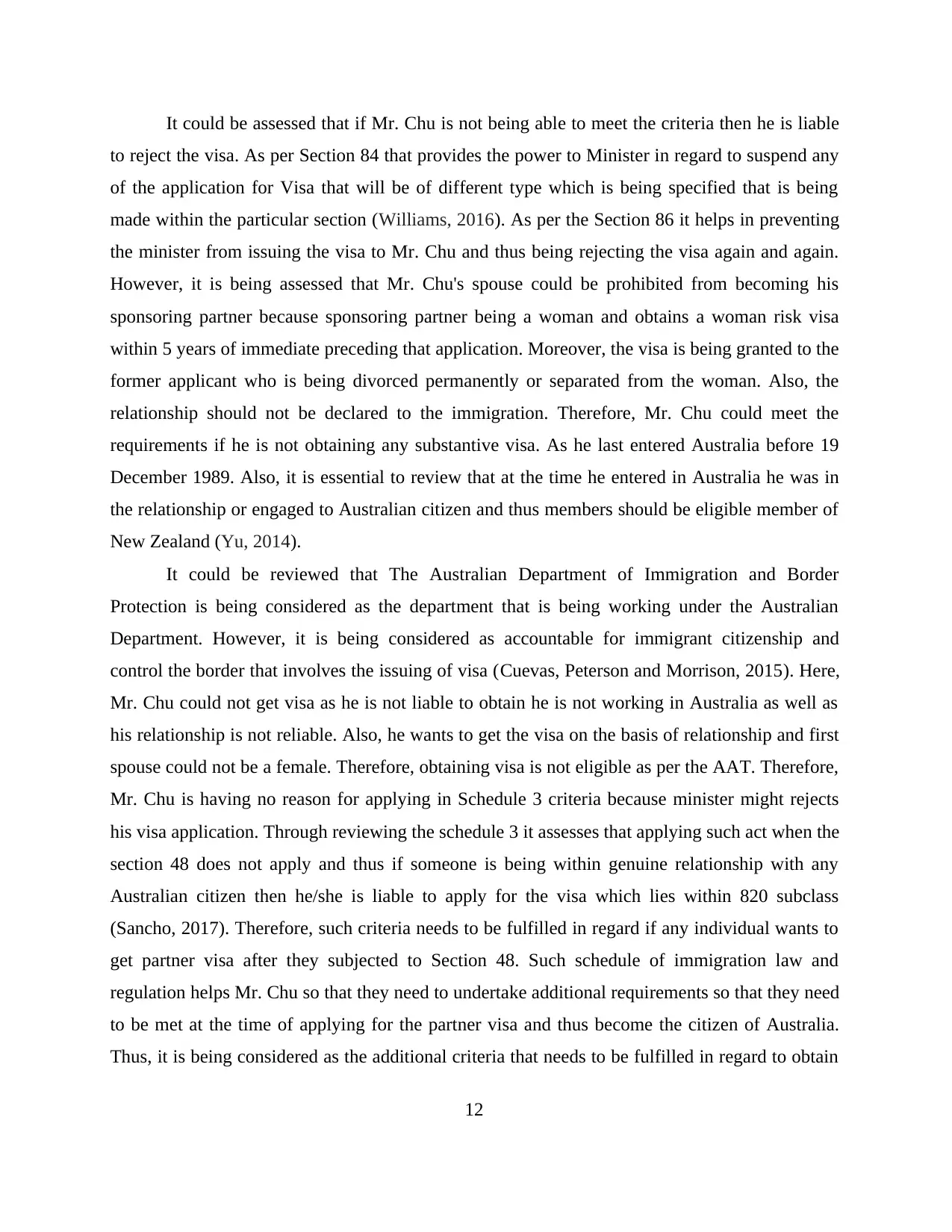
It could be assessed that if Mr. Chu is not being able to meet the criteria then he is liable
to reject the visa. As per Section 84 that provides the power to Minister in regard to suspend any
of the application for Visa that will be of different type which is being specified that is being
made within the particular section (Williams, 2016). As per the Section 86 it helps in preventing
the minister from issuing the visa to Mr. Chu and thus being rejecting the visa again and again.
However, it is being assessed that Mr. Chu's spouse could be prohibited from becoming his
sponsoring partner because sponsoring partner being a woman and obtains a woman risk visa
within 5 years of immediate preceding that application. Moreover, the visa is being granted to the
former applicant who is being divorced permanently or separated from the woman. Also, the
relationship should not be declared to the immigration. Therefore, Mr. Chu could meet the
requirements if he is not obtaining any substantive visa. As he last entered Australia before 19
December 1989. Also, it is essential to review that at the time he entered in Australia he was in
the relationship or engaged to Australian citizen and thus members should be eligible member of
New Zealand (Yu, 2014).
It could be reviewed that The Australian Department of Immigration and Border
Protection is being considered as the department that is being working under the Australian
Department. However, it is being considered as accountable for immigrant citizenship and
control the border that involves the issuing of visa (Cuevas, Peterson and Morrison, 2015). Here,
Mr. Chu could not get visa as he is not liable to obtain he is not working in Australia as well as
his relationship is not reliable. Also, he wants to get the visa on the basis of relationship and first
spouse could not be a female. Therefore, obtaining visa is not eligible as per the AAT. Therefore,
Mr. Chu is having no reason for applying in Schedule 3 criteria because minister might rejects
his visa application. Through reviewing the schedule 3 it assesses that applying such act when the
section 48 does not apply and thus if someone is being within genuine relationship with any
Australian citizen then he/she is liable to apply for the visa which lies within 820 subclass
(Sancho, 2017). Therefore, such criteria needs to be fulfilled in regard if any individual wants to
get partner visa after they subjected to Section 48. Such schedule of immigration law and
regulation helps Mr. Chu so that they need to undertake additional requirements so that they need
to be met at the time of applying for the partner visa and thus become the citizen of Australia.
Thus, it is being considered as the additional criteria that needs to be fulfilled in regard to obtain
12
to reject the visa. As per Section 84 that provides the power to Minister in regard to suspend any
of the application for Visa that will be of different type which is being specified that is being
made within the particular section (Williams, 2016). As per the Section 86 it helps in preventing
the minister from issuing the visa to Mr. Chu and thus being rejecting the visa again and again.
However, it is being assessed that Mr. Chu's spouse could be prohibited from becoming his
sponsoring partner because sponsoring partner being a woman and obtains a woman risk visa
within 5 years of immediate preceding that application. Moreover, the visa is being granted to the
former applicant who is being divorced permanently or separated from the woman. Also, the
relationship should not be declared to the immigration. Therefore, Mr. Chu could meet the
requirements if he is not obtaining any substantive visa. As he last entered Australia before 19
December 1989. Also, it is essential to review that at the time he entered in Australia he was in
the relationship or engaged to Australian citizen and thus members should be eligible member of
New Zealand (Yu, 2014).
It could be reviewed that The Australian Department of Immigration and Border
Protection is being considered as the department that is being working under the Australian
Department. However, it is being considered as accountable for immigrant citizenship and
control the border that involves the issuing of visa (Cuevas, Peterson and Morrison, 2015). Here,
Mr. Chu could not get visa as he is not liable to obtain he is not working in Australia as well as
his relationship is not reliable. Also, he wants to get the visa on the basis of relationship and first
spouse could not be a female. Therefore, obtaining visa is not eligible as per the AAT. Therefore,
Mr. Chu is having no reason for applying in Schedule 3 criteria because minister might rejects
his visa application. Through reviewing the schedule 3 it assesses that applying such act when the
section 48 does not apply and thus if someone is being within genuine relationship with any
Australian citizen then he/she is liable to apply for the visa which lies within 820 subclass
(Sancho, 2017). Therefore, such criteria needs to be fulfilled in regard if any individual wants to
get partner visa after they subjected to Section 48. Such schedule of immigration law and
regulation helps Mr. Chu so that they need to undertake additional requirements so that they need
to be met at the time of applying for the partner visa and thus become the citizen of Australia.
Thus, it is being considered as the additional criteria that needs to be fulfilled in regard to obtain
12
⊘ This is a preview!⊘
Do you want full access?
Subscribe today to unlock all pages.

Trusted by 1+ million students worldwide
1 out of 18
Related Documents
Your All-in-One AI-Powered Toolkit for Academic Success.
+13062052269
info@desklib.com
Available 24*7 on WhatsApp / Email
![[object Object]](/_next/static/media/star-bottom.7253800d.svg)
Unlock your academic potential
Copyright © 2020–2025 A2Z Services. All Rights Reserved. Developed and managed by ZUCOL.




